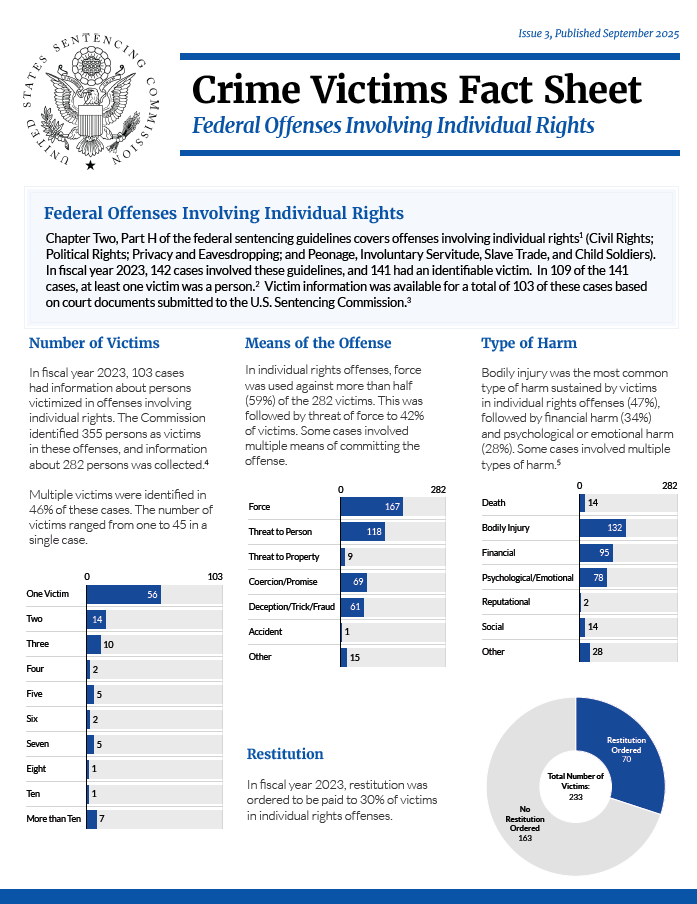CRIME VICTIMS FACT SHEET
Federal Offenses Involving Individual Rights
Chapter Two, Part H of the federal sentencing guidelines covers offenses involving individual rights1 (Civil Rights; Political Rights; Privacy and Eavesdropping; and Peonage, Involuntary Servitude, Slave Trade, and Child Soldiers).
In fiscal year 2023, 142 cases involved these guidelines, and 141 had an identifiable victim. In 109 of the 141 cases, at least one victim was a person.2 Victim information was available for a total of 103 of these cases based on court documents submitted to the U.S. Sentencing Commission.3
Click the button for a PDF or learn more below.
NUMBER OF VICTIMS
In fiscal year 2023, 103 cases had information about persons victimized in offenses involving individual rights. The Commission identified 355 persons as victims in these offenses, and information about 282 persons was collected.4
Multiple victims were identified in 46% of these cases. The number of victims ranged from one to 45 in a single case.
MEANS OF THE OFFENSE
In individual rights offenses, force was used against more than half (59%) of the 282 victims. This was followed by threat of force to 42% of victims. Some cases involved multiple means of committing the offense.
TYPE OF HARM
Bodily injury was the most common type of harm sustained by victims in individual rights offenses (47%), followed by financial harm (34%) and psychological or emotional harm (28%). Some cases involved multiple types of harm.5
RESTITUTION
In fiscal year 2023, restitution was ordered to be paid to 30% of victims in individual rights offenses.
RELATIONSHIPS BETWEEN VICTIMS AND INDIVIDUALS WHO CAUSED HARM
In individual rights offenses, the most common association between victims and the individuals who caused them harm was as a stranger (32%). The next most common was as an employer, employee, or coworker (21%). Some cases involved multiple relationship types.
60% of victims in individual rights offenses were harmed by more than one individual.
VULNERABILITY
Some individual rights offenses involved victims who were unusually vulnerable due to age, physical or mental condition, or other factors.6 The Commission identified 42% of victims in these cases as unusually vulnerable for one of these reasons. Some cases involved multiple vulnerabilities.
VICTIM CHARACTERISTICS
More than one-tenth (11%) of victims in individual rights offenses were juveniles.
More than one-third (37%) of victims in individual rights offenses were female.
ENDNOTES
1 Federal Offenses Involving Individual Rights include individuals sentenced in fiscal year 2023 in cases involving USSG §§2H1.1. (Offenses Involving Individual Rights); 2H2.1. (Obstructing an Election or Registration); 2H3.1. (Interception of Communications; Eavesdropping; Disclosure of Certain Private or Protected Information); 2H3.3. (Obstructing Correspondence); or 2H4.1. (Peonage, Involuntary Servitude, Slave Trade, and Child Soldiers). Multiple sentencing guidelines may have been applied in these cases, including some not listed above.
2 An identifiable victim can be a person, business, government, or other type. This series provides victim information on persons.
3 The Commission’s Crime Victims Fact Sheets series relies on information collected and analyzed through a special coding project undertaken by the Commission to gather information beyond what is regularly collected and reported on by the Commission.
4 The sentencing documents received from the courts by the Commission are often focused on the sentencing event; therefore, some information regarding the victims of the offense was not provided in the documents available for staff review. For this reason, the total number of cases with complete information, and the corresponding number of victims in those cases, will vary by analysis. Victim information was collected for the first ten persons documented in the records.
5 In a small number of cases, the type of harm resulted from additional counts of conviction for offenses other than the ones discussed in this fact sheet. All of the harm types involved in a case are reported in this fact sheet.
6 In some, but not all, of these cases the court applied the adjustment at USSG §3A1.1. Vulnerability due to advanced age or youthfulness was determined by the offense conduct stated in the presentence investigation report adopted by the court, and not based on any minimum or maximum age.
SOURCE: U.S Sentencing Commission, 2023 Victim Datafile, VICFY23.

